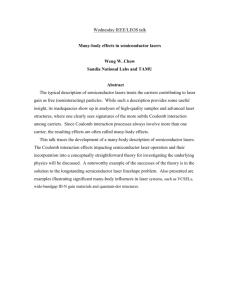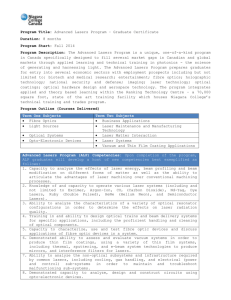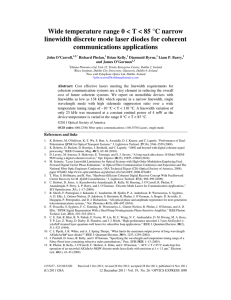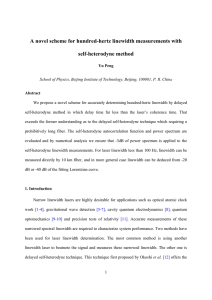Ultralow-noise packaged 1.55-m semiconductor external- cavity laser with 0.37-W output power
advertisement
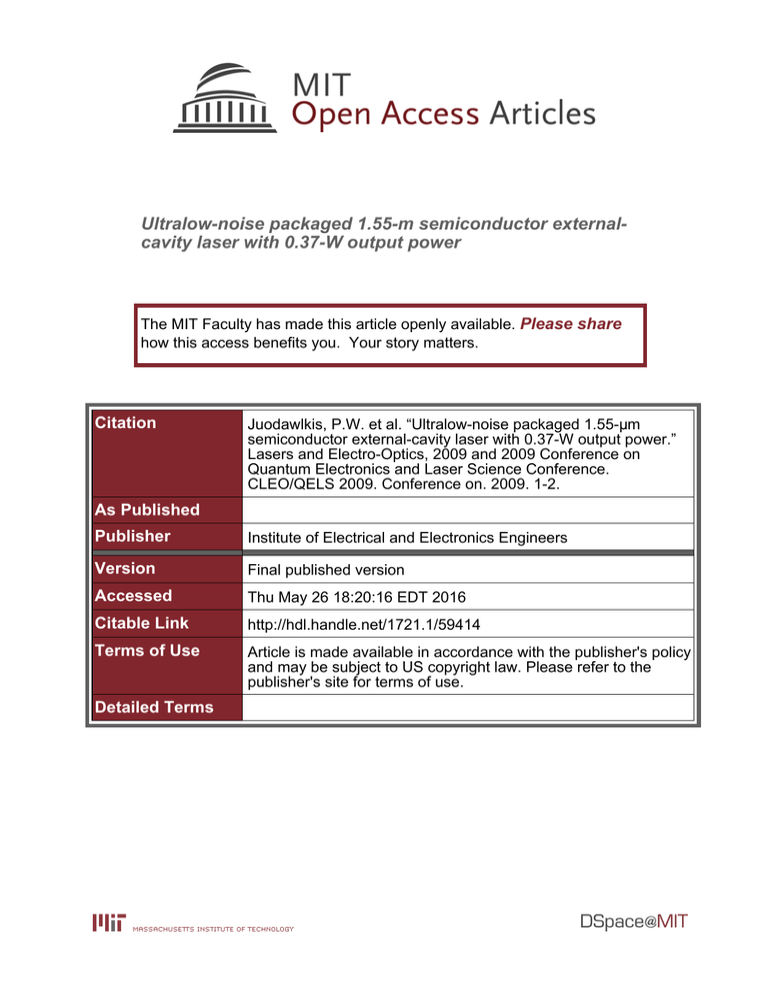
Ultralow-noise packaged 1.55-m semiconductor externalcavity laser with 0.37-W output power The MIT Faculty has made this article openly available. Please share how this access benefits you. Your story matters. Citation Juodawlkis, P.W. et al. “Ultralow-noise packaged 1.55-µm semiconductor external-cavity laser with 0.37-W output power.” Lasers and Electro-Optics, 2009 and 2009 Conference on Quantum Electronics and Laser Science Conference. CLEO/QELS 2009. Conference on. 2009. 1-2. As Published Publisher Institute of Electrical and Electronics Engineers Version Final published version Accessed Thu May 26 18:20:16 EDT 2016 Citable Link http://hdl.handle.net/1721.1/59414 Terms of Use Article is made available in accordance with the publisher's policy and may be subject to US copyright law. Please refer to the publisher's site for terms of use. Detailed Terms a3758_1.pdf CPDA3.pdf CPDA3.pdf © 2009 OSA/CLEO/IQEC 2009 Ultralow-Noise Packaged 1.55-µm Semiconductor External-Cavity Laser with 0.37-W Output Power P. W. Juodawlkis, W. Loh, F. J. O’Donnell, M. A. Brattain, J. J. Plant Lincoln Laboratory, Massachusetts Institute of Technology, Lexington, MA 02420 juodawlkis@ll.mit.edu Abstract: We demonstrate a semiconductor external-cavity laser comprising a slab-coupled optical waveguide amplifier (SCOWA) and a fiber Bragg grating. The laser exhibits a Lorentzian linewidth of 1.75 kHz and a sidemode suppression ratio > 80 dB. ©2009 Optical Society of America OCIS Codes: (140.3570) Lasers, single-mode; (300.3700) Linewidth; (250.5980) Semiconductor optical amplifiers 1. Introduction High-power, low-noise, single-frequency lasers are important for coherent communications and laser radar, microwave photonic links, and precision optical metrology. Semiconductor external-cavity lasers (ECLs) at 1.5 µm have exhibited kilohertz-class linewidth, but their output power PO has been limited a few milliwatts [1,2]. Highpower 1.5-µm distributed feedback (DFB) lasers have produced PO = 0.44-W with linewidth > 1 MHz [3]. Our work aims to attain ECLs having both high power and narrow linewidth by utilizing the slab-coupled optical waveguide (SCOW) gain medium and a fiber Bragg grating (FBG) external cavity [4,5]. Previously, we have achieved PO = 0.2 W and Lorentzian linewidth ∆νL = 40 kHz. Here, we report a packaged ECL having nearly twice the output power (PO = 0.37 W), a factor of 20 reduction in the Lorentzian linewidth (∆νL ~ 1.75 kHz), and no evidence of a relaxation oscillation resonance or residual longitudinal sidemodes above the shot-noise-limited floor (-162 dB/Hz) of the measured relative intensity noise (RIN) spectrum. 2. Slab-Coupled Optical Waveguide External-Cavity Laser (SCOWECL) Configuration The packaged SCOWECL (Fig. 1) consists of a double-pass, curved-channel SCOW amplifier (CC-SCOWA), a narrow-bandwidth FBG (λC = 1550 nm, ∆λ = 20 pm, R = 20%), and an optical isolator. A 3-cm-long lensed fiber (6.5-µm spot size) was spliced to the FBG to increase the coupling efficiency to the SCOWA. A center-wavelength tuning range of 1.5 nm was achieved by mounting the FBG to a piezoelectric transducer (PZT) and applying 1000 V to the PZT. For the data reported here, VPZT = 0. The SCOWA material design consists of a 4.6-µm-thick, lightly n-doped InGaAsP waveguide that is weakly coupled (Γ ~ 0.25%) to an InGaAlAs quantum-well (QW) active region. The active region comprises four 7-nm compressive-strained (+1%) InGaAlAs QWs, 8-nm tensile-strained (-0.3%) InGaAlAs barriers, and a 15-nm p-doped InAlAs electron-blocking layer. The QW photoluminescence peak λ = 1565 nm. A double-pass, 1-cm- (a) (b) Fig. 1. Schematic (a) and photograph (b) of 1.55-µm packaged slab-coupled optical waveguide external cavity laser (SCOWECL). 978-1-55752-869-8/09/$25.00 ©2009 IEEE Fig. 2. Continuous-wave (CW) power-current-voltage (L-I-V) characteristics of the packaged SCOWECL. a3758_1.pdf CPDA3.pdf CPDA3.pdf Fig. 3. Lineshape of the packaged SCOWECL at 4-A bias current. Laser output power = 0.37 W. Lorentzian lineshape (∆νL = 1.75 kHz) also shown (dashed). © 2009 OSA/CLEO/IQEC 2009 Fig. 4. Relative intensity noise (RIN) spectrum of the packaged SCOWECL at 4-A bias current. Laser output power = 0.37 W. Shot-noise limited RIN of photodiode also shown (dashed). long SCOWA was realized by using a curved-channel (10-cm radius) waveguide geometry that provides both a high-reflectivity (R > 95%) flat facet and an anti-reflection-coated, 5-degree-angled facet. The SCOWA was mounted junction-side down to a Cu-W heatsink and temperature controlled using a thermo-electric cooler. The angled SCOWA facet was coupled to the lensed fiber and affixed using laser welding. Other design and fabrication details can be found elsewhere [4,6]. 3. SCOWECL Characterization Results Figure 2 shows the SCOWECL output power and bias voltage as a function of bias current. The threshold current is 0.9A and a maximum output power of 0.37 W is attained for I = 4 A. The jagged behavior of the power-current (L-I) curve is attributed to longitudinal-mode hopping. Stable regions of single-longitudinal-mode operation were attained for I < 4 A. The electrical-to-optical conversion efficiency at 4 A is calculated to be ηE-O = 7%. Before deciding to use a FBG having R = 20%, we determined that higher output power could be obtained with R = 10% (PO = 0.46 W at I = 4A) at the expense of degraded laser noise performance. The spectral lineshape of the SCOWECL at I = 4 A (Fig. 3) was determined to have a Voigt distribution using the self-heterodyne linewidth measurement technique with a differential delay of 250 µs. The Voigt lineshape has a Lorentzian (white noise) tail with linewidth ∆νL ~ 1.75 kHz (dashed line) that is spectrally broadened by 1/f noise to a Gaussian linewidth ∆νG = 35 kHz. To our knowledge, this is the smallest Lorentzian linewidth from a semiconductor laser having PO > 100 mW. The RIN spectrum of the SCOWECL at I = 4 A (Fig. 4) was shot-noise limited (IPD = 5 mA) at -162 dB/Hz from 0.1 to 10 GHz. Note that there is no evidence of either a relaxation oscillation resonance or residual sidemodes above the RIN floor. This implies that the sidemode suppression ratio (SMSR) exceeds 80 dB. Calculations predict that the relaxation oscillation should be below this RIN level for the SCOWA gain medium and cavity used here. 4. References 1. R. Wyatt, “Spectral linewidth of external cavity semiconductor lasers with strong, frequency-selective feedback,” Electron. Lett. 21, 658-659 (1985). 2. W. H. Loh, R. I. Lamming, M. N. Zervas, M. C. Farries, and U. Koren, “Single frequency erbium fiber external cavity semiconductor laser,” Appl. Phys. Lett. 66, 3422-3424 (1995). 3. R. Menna, A. Komissarov, M. Maiorov, V. Khalfin, L. DiMarco, J. Connolly, and D. Garbuzov, “High power 1550 nm distributed feedback lasers with 440 mW CW output power for telecommunication applications,” in Proc. Conference on Lasers and Electro-Optics (CLEO), 2001, pp. CPD12. 4. P. W. Juodawlkis, J. J. Plant, F. J. O'Donnell, L. J. Missaggia, R. K. Huang, and J. P. Donnelly, “Narrow-linewidth, high-power 1556-nm slabcoupled optical waveguide external-cavity laser,” in Proc. Conference on Lasers and Electro-Optics (CLEO), 2005, pp. 411-413. 5. P. W. Juodawlkis, J. J. Plant, F. J. O'Donnell, K. E. Jensen, R. K. Huang, L. J. Missaggia, D. O. Caplan, J. T. Gopinath, B. Chann, D. J. Ripin, and J. P. Donnelly, “High-power, low-noise 1.5-µm slab-coupled optical waveguide amplifiers (SCOWAs) and their applications,” in Proc. International Symposium on Contemporary Photonics Technology (CPT), 2007, pp. 139-142. 6. P. W. Juodawlkis, J. J. Plant, R. K. Huang, L. J. Missaggia, and J. P. Donnelly, “High-power 1.5-µm InGaAsP/InP slab-coupled optical waveguide amplifier,” IEEE Photon. Technol. Lett. 17, 279-281 (2005).



